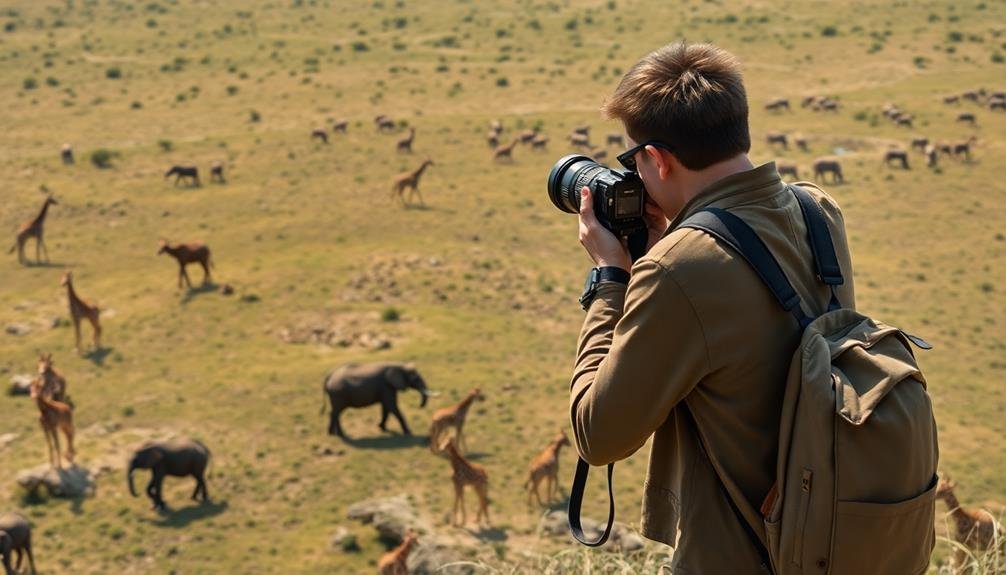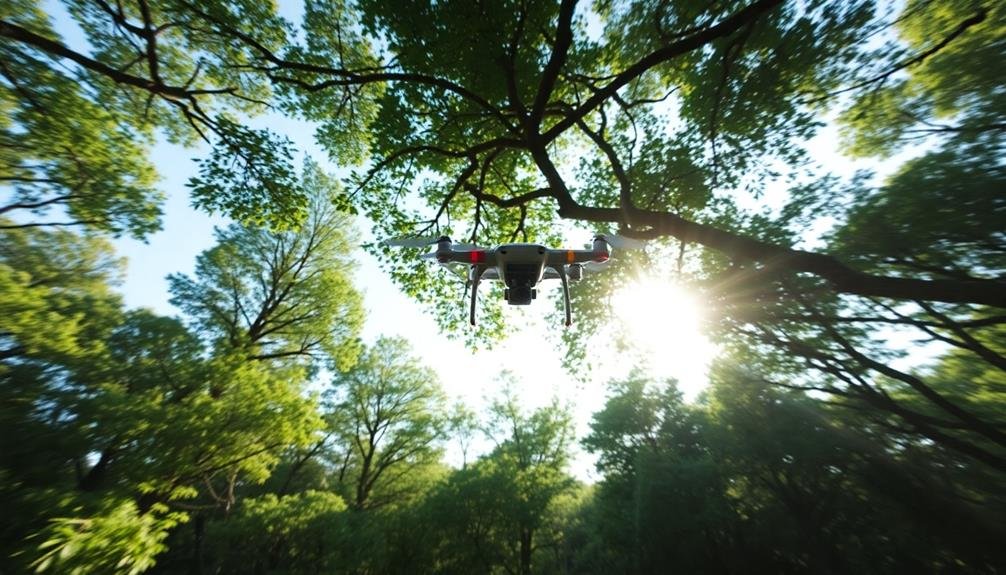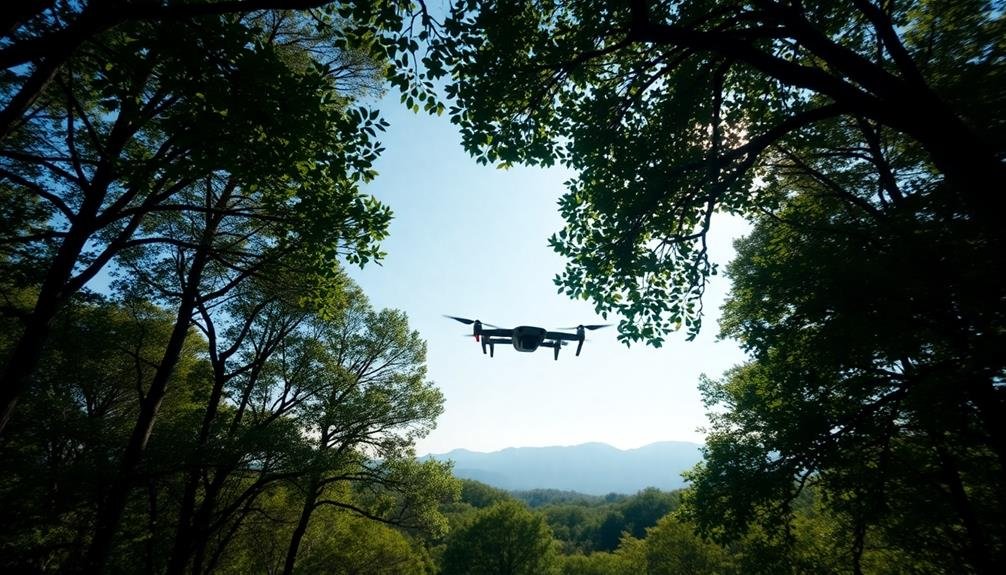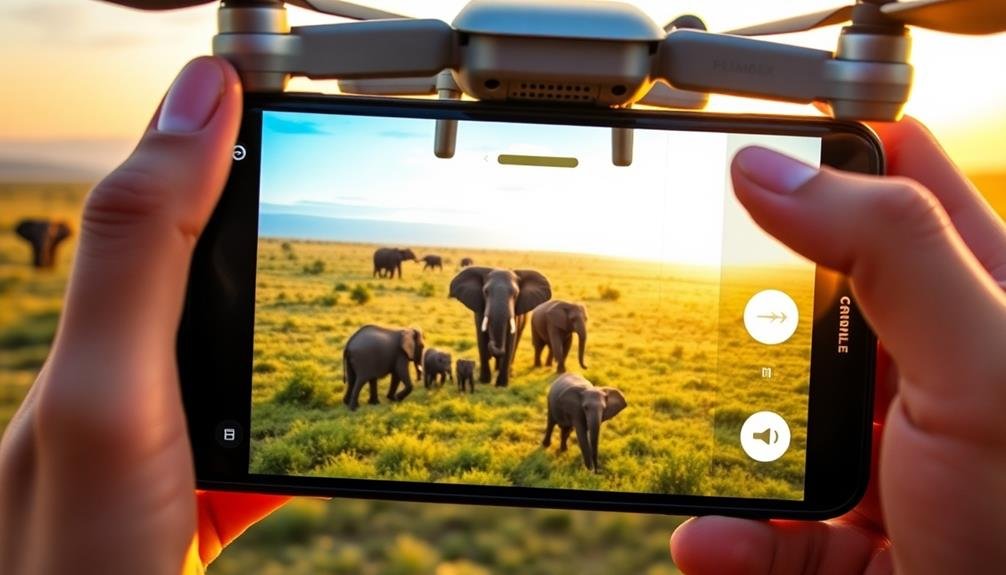When capturing wildlife from above, prioritize ethical practices to protect animals and their habitats. Maintain a safe distance of at least 100 meters from wildlife, and respect sensitive ecosystems. Always follow local regulations, as many areas restrict or ban drone use. Minimize noise and disturbance by using quiet drones and avoiding sudden movements. Share your photos responsibly, avoiding location disclosure to prevent over-tourism. Educate others about conservation through your work. By adhering to these guidelines, you'll not only capture stunning images but also contribute to wildlife preservation. Discover how these tips can elevate your photography while safeguarding nature's delicate balance.
Maintain Safe Distances

When it comes to wildlife photography, maintaining a safe distance is essential for both your safety and the well-being of the animals. As you capture aerial shots, remember that your presence can disturb or stress wildlife. Always keep your drone at least 100 meters away from animals to minimize disturbance.
Be aware of local regulations and protected areas where drone use may be restricted or prohibited. Research the species you're photographing to understand their behavior and sensitivity to disturbances. Some animals may perceive drones as predators, causing unnecessary stress or altering their natural behaviors.
Use your zoom lens to get close-up shots without physically approaching the animals. This technique allows you to capture stunning images while respecting wildlife habitats.
If you notice signs of distress, such as animals fleeing or becoming agitated, immediately increase your distance or leave the area.
Respect Wildlife Habitats

Respecting wildlife habitats goes hand in hand with maintaining safe distances. As you capture images from above, it's essential to understand the impact your presence can have on the environment. Be aware of nesting sites, feeding grounds, and sensitive ecosystems. Avoid disturbing these areas, especially during breeding seasons or migration periods.
When using drones or aerial platforms, follow local regulations and guidelines. Many protected areas have strict rules about flying over wildlife habitats. Research your location beforehand and obtain necessary permits. Keep your flights brief and purposeful to minimize disturbance.
Pay attention to signs of stress in animals below. If you notice changes in behavior, such as birds taking flight or animals fleeing, immediately retreat. Don't pursue or chase wildlife for the perfect shot. Instead, be patient and wait for natural opportunities.
Consider the noise levels of your equipment. Opt for quieter drones or use sound-dampening accessories when possible. This helps reduce stress on wildlife and preserves the natural soundscape.
Follow Local Regulations

Maneuvering the complex web of local regulations is essential for wildlife photographers. Before you commence on your aerial wildlife photography adventure, research and understand the specific rules governing drone use in your chosen location.
Many national parks, wildlife reserves, and protected areas have strict regulations or outright bans on drone operations to protect wildlife and preserve the natural environment.
Check with local authorities, park rangers, or conservation officers to obtain necessary permits and learn about any flight restrictions. Pay attention to no-fly zones, altitude limits, and time-of-day restrictions that may be in place. Some areas may require you to maintain a minimum distance from animals or nesting sites.
Be aware that regulations can vary considerably between countries, states, and even specific wildlife areas. What's permitted in one location may be illegal in another.
Stay informed about recent changes in drone laws, as they're constantly evolving.
Minimize Noise and Disturbance

One of the most essential aspects of wildlife photography is minimizing noise and disturbance to the animals you're capturing.
When you're photographing from above, whether using a drone or elevated platform, it's vital to be as unobtrusive as possible. This approach not only helps you get better shots but also protects the wildlife and their habitats.
To minimize your impact, always use the longest lens possible to maintain a safe distance from your subjects. This allows you to capture detailed images without encroaching on the animals' space.
Additionally, familiarize yourself with the behavior of the species you're photographing. Understanding their habits and routines will help you anticipate their movements and reduce the need for sudden adjustments that might startle them.
Here are three key strategies to minimize noise and disturbance:
- Use silent shooting modes on your camera
- Avoid sudden movements or loud conversations
- Plan your shots in advance to reduce time spent in the area
Share Responsibly and Educate Others

As you capture stunning wildlife images, it's crucial to share them responsibly and use your platform to educate others about conservation. When posting your photos online, avoid disclosing specific locations that could lead to over-tourism or disturbance of sensitive habitats. Instead, provide general information about the ecosystem or region.
Use your captions to share interesting facts about the species you've photographed, their behavior, and the challenges they face. Highlight conservation efforts and ways viewers can support wildlife protection. Be transparent about your photography techniques, mentioning if you used a drone or telephoto lens to maintain a safe distance.
Encourage ethical practices among fellow photographers by setting a positive example. Share your experiences with minimizing disturbance and respecting wildlife. If you witness unethical behavior, address it politely and educate others about better alternatives.
Consider partnering with conservation organizations to showcase your work and raise awareness. Offer your images for educational purposes or fundraising efforts.
Frequently Asked Questions
What Camera Settings Are Best for Aerial Wildlife Photography?
You'll want to use a fast shutter speed, at least 1/1000s, to minimize motion blur. Set your aperture to f/8 for sharpness, and increase ISO as needed. Use continuous autofocus and burst mode for capturing moving subjects.
How Do I Stabilize My Drone in Windy Conditions for Clearer Shots?
To stabilize your drone in windy conditions, you'll want to use a higher shutter speed, engage the drone's stabilization features, and fly in sport mode. Practice smooth movements, and consider using a ND filter for better exposure control.
Are There Specific Times of Day Best for Photographing Wildlife From Above?
You'll get the best wildlife shots from above during early morning or late afternoon. These golden hours offer softer light and more animal activity. Avoid midday when creatures often seek shelter and harsh sunlight can affect image quality.
What Post-Processing Techniques Can Enhance Aerial Wildlife Photos Without Misrepresenting Reality?
You can enhance aerial wildlife photos through gentle adjustments to contrast, saturation, and sharpness. Avoid excessive editing or adding/removing elements. Use cropping to improve composition. Always aim to maintain the scene's authenticity and natural appearance.
How Can I Identify Different Animal Species From Aerial Footage?
You'll need to study animal shapes, sizes, and movement patterns from above. Use field guides and online resources to learn distinctive features. Practice identifying species in photos first. Consult experts if you're unsure about specific animals.
In Summary
You've learned five key ethical principles for wildlife photography from above. By maintaining safe distances, respecting habitats, following regulations, minimizing disturbance, and sharing responsibly, you're helping protect the animals you're capturing. Remember, it's not just about getting the perfect shot – it's about preserving nature for future generations. As you head out with your camera, keep these tips in mind. You'll create stunning images while being a responsible steward of the environment.

As educators and advocates for responsible drone use, we’re committed to sharing our knowledge and expertise with aspiring aerial photographers.




Leave a Reply